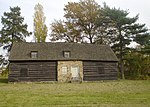Darby Creek (historically known as Church Creek or the Derby River) is a tributary of the Delaware River in Chester, Delaware and Philadelphia counties, in the U.S. Commonwealth of Pennsylvania. It is approximately 26 miles (42 km) long. The watershed of the creek has an area of 77.2 square miles (200 km2). It has twelve named direct tributaries, including Cobbs Creek, Little Darby Creek, Ithan Creek, and Muckinipattis Creek. The creek has a low level of water quality for most of its length. The lower Darby Creek area was deemed a Superfund site by the U.S. Environmental Protection Agency (EPA) due to contamination with dangerous chemicals from two landfills.
Darby Creek flows through a narrow valley in its upper reaches and a tidal flat in its lower reaches. The creek is in the Piedmont Uplands and Atlantic Coastal Plain physiographic provinces. Major rock formations in the watershed include the Wissahickon Formation. Three small dams historically existed on the creek, but were removed in 2012. The watershed of the creek is largely developed, with roughly half a million people inhabiting it. Most of the watershed is in Delaware County, but some parts are in Chester County, Philadelphia County, and Montgomery County. The watershed is part of the Lower Delaware drainage basin.
Historically, the Lenni Lenape people inhabited the area in the vicinity of Darby Creek. By the 17th century, the Dutch and Swedish had arrived in the area, followed some years later by the English. Numerous mills of various types were eventually built along the creek and several railroads traversed the watershed. In modern times, grants by various organizations have been awarded to improve the creek and its watershed. The Darby Creek Valley Association operates within the watershed. Part of the creek's length is designated as a Coldwater Fishery and a Migratory Fishery, part is a Trout Stocked Fishery and a Migratory Fishery. Various species of fish, including redbreast sunfish, eels, and trout, inhabit it. Several areas in the vicinity of the creek are listed on the Delaware County Natural Areas Inventory. These include the Darby Creek Mouth Mudflat, the John Heinz National Wildlife Refuge, and the Ithan-Darby Creek Wetlands. A reach of the creek is navigable by canoe.









